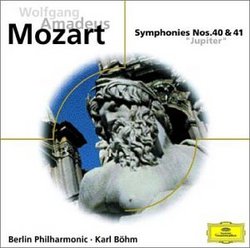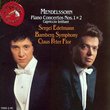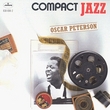| All Artists: Wolfgang Amadeus Mozart, Karl Böhm, Berlin Philharmonic Brass Ensemble, Berlin Philharmonic Orchestra Title: Mozart: Symphonies Nos. 40 and 41 Members Wishing: 0 Total Copies: 0 Label: Deutsche Grammophon Release Date: 4/10/2001 Album Type: Original recording remastered Genre: Classical Styles: Opera & Classical Vocal, Historical Periods, Classical (c.1770-1830), Symphonies Number of Discs: 1 SwapaCD Credits: 1 UPC: 028946962022 |
Search - Wolfgang Amadeus Mozart, Karl Böhm, Berlin Philharmonic Brass Ensemble :: Mozart: Symphonies Nos. 40 and 41
 | Wolfgang Amadeus Mozart, Karl Böhm, Berlin Philharmonic Brass Ensemble Mozart: Symphonies Nos. 40 and 41 Genre: Classical
|
Larger Image |
CD DetailsSimilarly Requested CDs
|
CD ReviewsWhat can I say... Michael Newberry | Santa Monica | 05/20/2002 (5 out of 5 stars) "For over twenty years I have tried to love Mozart. Without fail, every hearing of his work made my skin crawl. I would hear interviews with great musicians and singers raving about his genius. Knowing that he must be great, I would buy another recording with my favorite singer or conductor...nope, that didn't work--the music hurt my ears. What I thought strange is that I love Bach and Beethoven and Opera, why didn't Mozart do it for me? Two months ago I was driving through New York State and I was listening to WQXR, and they began to play one of Mozart's Symphonies, WHAM...every cord, note, phrase was singing to me--it sounded so RIGHT. That feeling did not leave until the final note--I had to hear who was the conductor. I guess that none of you Mozart lovers will be shocked--the conductor was Karl Bohm. When I got home I listened to many Amazon's highlights of Bohm's recordings of Mozart, and I bought four: Magic Flute, the Requim, Eine Kleine Nachtmusik, and Syphonies 40 and 41. Now, finally after all these years, I have found Mozart pieces I love. Thanks to Karl Bohm." Two fabulous symphonies in a justly famous recording Craig Matteson | Ann Arbor, MI | 08/23/2005 (5 out of 5 stars) "Karl Böhm was a famous Austrian conductor who had a special devotion to Mozart, Beethoven, and Richard Strauss. He was justly famous for his interpretations of these composers in his performances and recordings. His recordings of the Mozart symphonies in the 1970s continue to stand the test of time even if they do not display the current fashion in playing Mozart.
Symphonies 40 & 41 are the last two symphonies of Mozart and are glorious treasures of the symphonic form and of all musical arts. These, along with Symphony 39, were composed in a few months in 1788. The two here are the most performed, but all three deserve the highest praise and reward close listening. The opening of the g minor symphony (40) haunts us and is used so effectively against the other materials of the movement. The slow second movement has an elegance that sounds so simple, but the sixteenth-dotted eighth rhythm used throughout is not only hard to play on the beat for so long, it shifts things for the listener as well because we expect the short note to be a pick up and the long note on the beat. The menuet is unusually poignant in its minor key. The last movement soars. Materials from the other movements are reused in original ways that delight and amaze us. Symphony 41 became the "Jupiter" in the hands of the English impresario Salomon (who had done so well bringing Haydn to London). It is an utterly amazing work. The first movement has very unusual and otherworldly sonorities that you have to study the score to see how they are pulled off. However, the greatest miracle is the way imitation and fugue is used in the last movement, especially the coda where themes are brought back in a five part fugue that is worthy of Bach, but is utterly free and never sounds strict or fussy: a masterstroke for all time. To round things out the overture to "The Magic Flute" is included and will delight you as it has nearly everyone who has ever heard it (there are a few stick-in-the mud types). This is an amazingly priced disk and will reward as many listenings as you care to give it." |

 Track Listings (9) - Disc #1
Track Listings (9) - Disc #1

![Vivaldi's Ring of Mystery [With CD]](https://nationalbookswap.com/cd//m/30/0730/80730.jpg)






